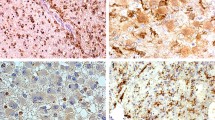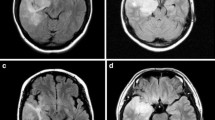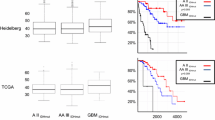Abstract
Our aim was to retrospectively evaluate the influence of gemistocytic astrocytes, cellular proliferation indices, immunoexpression of proteins p53 and bcl-2 in the clinical outcome of 39 patients with WHO grade II and III astrocytomas with the presence of gemistocytes. The mean proportion of gemistocytes was 18.7% and the mean proliferative index was 3.3%. Immunoexpression of p53 was detected in 29 cases (74.4%) and all cases (100%) were positive for bcl-2. The median overall survival was 97.2 months and the progression-free survival was 43.1 months. Estimated 1-, 5- and 10-year overall survival rates were 94.3%, 69.5% and 46.4%; 1-, 5- and 10-year progression-free survival rates were 91.1%, 26.1% and 13.1%. Out of 24 who presented clinical and neuroimaging worsening, characterized as tumor progression or recurrence, 16 had histological confirmation and were also analyzed. We could not detect significant differences when comparing all the indices between WHO grade II and III and also between the first and second biopsies. We also could not detect significant differences in progression-free and overall survival when analyzing the gemistocyte index and the immunohistochemical labeling indices p53, bcl-2 and MIB-1, as well as patientsȁ9 age (median value, up to 34 vs. over 34 years) and histological grade (II or III). Our finding confirms recent reports that question the role of gemistocytes as a prognostic factor in diffuse astrocytomas. The significance and role of gemistocytes in astrocytomas has yet to be defined and warrants further study.
Similar content being viewed by others
References
Nissl F (1904) Zur histopathologie der paralytischen rindenerkrankung. Histol Histopathol Arb Grosshim 1:316–494
Hoshino T, Wilson CB, Ellis WG (1975) Gemistocytic astrocytes in gliomas: an autoradiographic study. J Neuropathol Exp Neurol 34:263–281
Kros JM, Stefanko SZ, DeJong AAW, Van Vroonhoven CCJ, Van der Heul RO, Van der Kwast TH (1991) Ultrastructural and immunohistochemical segregation of gemistocytic subsets. Hum Pathol 22:33–40
Watanabe K, Tashibana O, Yonekawa Y, Kleihues P, Ohgaki H (1997) Role of gemistocytes in astrocytoma progression. Lab Invest 76:277–284
Kleihues P, Davis RL, Ohgaki H, Burger PC, Westphal MM, Cavenee WK (2000) Diffuse astrocytoma. In: Kleihues P, Cavenee WK (eds) Pathology and genetics of tumours of the nervous system. IARC, Lyon, pp 22–28
Krouwer HGJ, Davis RL, Silver P, Prados M (1991) Gemistocytic astrocytomas: a reappraisal. J Neurosurg 74:399–406
Kros JM, Schouten WCD, Jansen PJA, Vander Kwast TH (1996) Proliferation of gemistocytic cells and glial fibrilary acidic protein (GFAP) – positive oligodendroglial cells in gliomas: a MIB-1/GFAP double labeling study. Acta Neuropathol 91:99–103
Watanabe K, Peraud A, Gratas C, Wakai S, Kleihues P, Ohgaki H (1998) p53 and PTEN gene mutations in gemistocytic astrocytomas. Acta Neuropathol 95:559–564
Kösel S, Scheithauer BW, Graeber MB (2001) Genotype-phenotype correlation in gemistocytic astrocytomas. Neurosurgery 48:187–194
Reis RM, Hara A, Kleihues P, Ohgaki H (2001) Genetic evidence if the neoplastic nature of gemistocytes in astrocytomas. Acta Neuropathol 102:422–425
Tihan T, Vohra P, Berger MS, Keles GE (2006) Definition and diagnostic implications of gemistocytic astrocytomas: a pathological perspective. J Neurooncol 76:175–183
Onda K, Davis RL, Wilson CB, Hoshino T (1994) Regional differences in bromodeoxyuridine uptake, expression of Ki-67 protein and nucleolar organizer region counts in glioblastoma multiforme. Acta Neuropathol 87:586–593
Yang HJ, Kim JE, Paek SH, Chi JG, Jung H-W, Kim DG (2003) The significance of gemistocytes in astrocytoma. Acta Neurochir (Wien) 145:1097–1103
Burger PC, Scheithauer BW (1994) Tumors of neuroglia and choroids plexus epithelium. In: Burger PC, Scheithauer BW (eds) Tumors of the central nervous system. Armed Forces Institute of Pathology, Washington, pp 25–161
McLendon RE, Enterline DS, Tien RD, Thorstad WL, Bruner JM (1998) Tumors of central neuroepithelial origin. In: Bigner DD, McLendon RE, Bruner JM (eds) Russell and Rubinstein´s pathology of tumors of the nervous system, 6th edn. Arnold Press, London, pp 307–57
Ellison D, Love S, Chimelli L, Harding BN, Lowe J, Vinters HV (2004) Astrocytic neoplasms. In: Neuropathology, Mosby, London, pp 623–640
Watanabe K, Tachibana O, Sato K, Yonekawa Y, Kleihues P, Ohgaki H (1996) Overexpression of the EGF receptor and p53 mutations are mutually exclusive in the evolution of primary and secondary glioblastomas. Brain Pathol 6:217–224
Watanabe K, Sato K, Biernat W, Tachibana O, Ammon K, Ogata N (1997) Incidence and timing of p53 mutations during astrocytoma progression in patients with multiple biopsies. Clin Cancer Res 3:523–530
Perry A, Jenkins RB, O'Fallon JR, Schaefer PL, Kimmel DW, Mahoney MR, Scheithauer BW, Smith SM, Hill EM, Sebo TJ, Levitt R, Krook J, Tschetter LK, Morton RF, Buckner JC (1999) Clinicopathologic study of 85 similarly treated patients with anaplastic astrocytic tumors. An analysis of DNA content (ploidy), cellular proliferation, and p53 expression. Cancer 86:672–683
Yaziji H, Massarani-Wajai R, Gujrati M, Kuhns JG, Martin AW, Parker JC (1996) Role of p53 immunohistochemistry in differentiating reactive gliosis from malignant astrocytic lesions. Am J Surg Pathol 20:1086–1090
Vital A, Loiseau H, Kantor G, Daucort V, Chene G, Cohadon F, Rougier A, Rivel J, Vital C (1998) p53 protein expression in grade II astrocytomas; immunohistochemical study of 100 cases with long-term follow-up. Pathol Res Pract 194:831–836
Rathore A, Kamarajan P, Mathur M, Sinhas S, Sarkar C (1999) Simultaneous alterations of retinoblastoma and p53 protein expression in astrocytic tumours. Pathol Oncol Res 5:21–27
IARC TP53 Mutation database [on line]. [cited 2005 Aug 1]. Available from: URL:http://www-p53.iarc.fr/
Soussi T (2000) The p53 tumor suppressor gene: from molecular biology to clinical investigation. Ann NY Acad Sci 910:121–139
Krajewski S, Krajewska M, Ehrmann J, Siroska M, Lach B, Chatten J, Reed JC (1997) Immunohistochemical analysis of Bcl-2, Bcl-X, Mcl-1, and Bax in tumors of central and peripheral nervous system origin. Am J Pathol 150:805–814
Rodriguez-Pereira C, Suarez-Peñaranha M, Barros F, Sobrido MJ, Vasquez-Salvado M, Forteza J (2001) Analysis of 2 antiapoptotic factors in gliomas: bcl-2 overexpression and p53 mutations. Arch Pathol Lab Med 125:218–223
Korshunov A, Golanov A, Sycheva R, Pronin I (1999) Prognostic value of tumours associated antigen immunoreactivity and apoptosis in cerebral glioblastomas; an analysis of 168 cases. J Clin Pathol 52: 574–580
Peraud A, Ansari H, Bise K, Reulen HJ (1998) Clinical outcome of supratentorial astrocytoma WHO grade II. Acta Neurochir (Wien) 140:1213–1222
Acknowledgement
The authors thank Ângela Tavares Paes for her assistance in statistical analysis.
Author information
Authors and Affiliations
Corresponding author
Rights and permissions
About this article
Cite this article
Martins, D.C., Malheiros, S.M., Santiago, L.H. et al. Gemistocytes in astrocytomas: Are they a significant prognostic factor?. J Neurooncol 80, 49–55 (2006). https://doi.org/10.1007/s11060-006-9149-6
Received:
Accepted:
Published:
Issue Date:
DOI: https://doi.org/10.1007/s11060-006-9149-6




